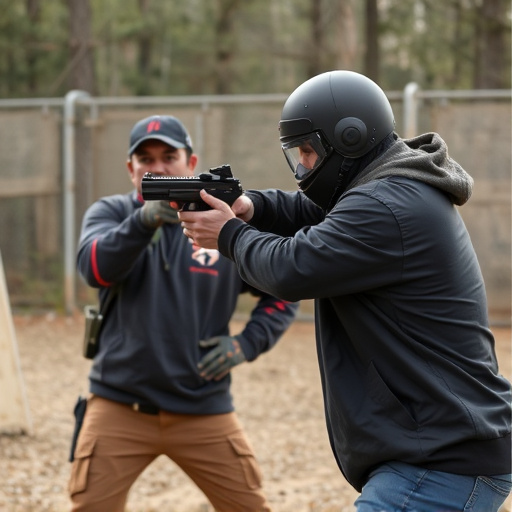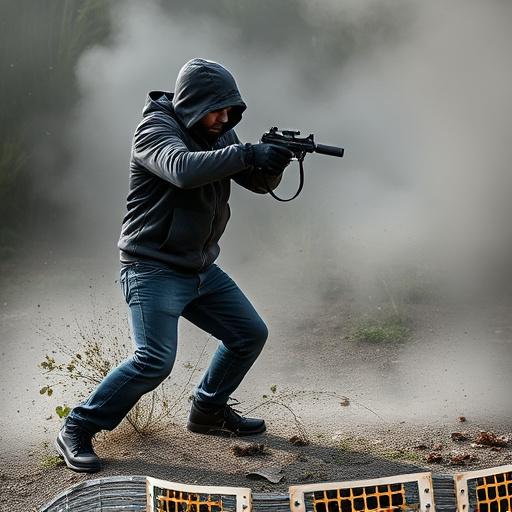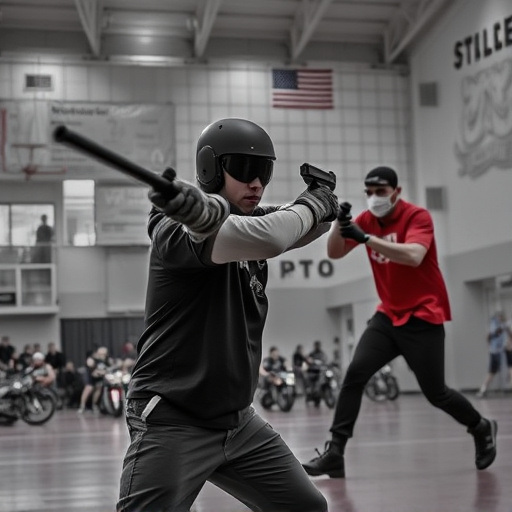Mini stun guns, disguised as everyday items like flashlights or keychains, offer compact self-defense solutions with high voltage, low current pulses capable of temporarily incapacitating assailants. However, they pose significant long-term neurological risks, including cognitive issues and seizures, even at lower voltage settings. Understanding these risks is crucial for safe and responsible use in diverse environments, including those exposed to water. Legal regulations vary by region, with some areas imposing restrictions or bans based on potential long-term neurological stun effects, especially for high-risk individuals. Concealing mini stun guns through specialized holsters or everyday item integrations ensures discretion while maintaining accessibility. Responsible use includes rigorous training, adherence to local laws, proper handling and storage, regular battery checks, awareness of side effects, and immediate medical attention for any long-term neurological issues, with regular physical training mitigating risks by enhancing fitness and reaction times.
Uncover the power and discretion of mini stun guns, compact self-defense tools designed for personal safety. This comprehensive guide explores the intricacies of these devices, focusing on their concealment options and potential long-term neurological effects. We delve into legal landscapes surrounding ownership, offering insights to stay within regulatory boundaries. From innovative concealment strategies to essential safety practices, this article equips readers with knowledge to make informed choices. Understand the impact, stay informed, and empower yourself with the right tools for self-defense.
- Understanding Mini Stun Guns and Their Concealment
- Long-Term Neurological Effects of Stun Devices
- Legal Considerations for Ownership and Concealment
- Popular Concealment Options for Mini Stun Guns
- Safety Precautions and Best Practices for Users
Understanding Mini Stun Guns and Their Concealment

Mini stun guns, also known as personal stun devices, are compact and non-lethal weapons designed to temporarily incapacitate an assailant through electric shock. Unlike traditional stun guns, their smaller size allows for easier concealment, making them a preferred option for individuals seeking self-defense solutions that offer both portability and discreteness. These devices typically deliver a high voltage, low current electrical pulse, which can cause muscle contractions, disorientation, and even temporary paralysis in the target. Understanding the long-term neurological stun effects is crucial, as it adds another layer of caution and responsibility when considering the use of such devices.
When it comes to concealment, mini stun guns offer various options for integration into everyday life. They can be disguised as everyday items like flashlights, pens, or even keychains, ensuring users can carry them on their persons without drawing unnecessary attention. Some models feature ergonomic designs that make them comfortable to hold and easy to operate with one hand, further enhancing their practicality. Additionally, advanced technologies have enabled manufacturers to create stun devices with enhanced durability and water resistance, making them suitable for diverse environments and conditions.
Long-Term Neurological Effects of Stun Devices

While stun guns are designed as non-lethal self-defense tools, it’s crucial to understand their potential for long-term neurological effects. Studies have shown that stun devices can cause significant disruptions in brain function, even with lower voltage settings. The impact can lead to temporary or permanent cognitive issues such as memory loss, concentration difficulties, and in some cases, even seizures. These effects may not immediately present themselves, making it important for users to consider the potential risks associated with repeated or prolonged stun gun usage.
Long-term neurological stun effects can manifest differently in individuals, with symptoms ranging from subtle changes in mental clarity to more severe neurologic disorders. Regular exposure to stun devices could contribute to chronic brain injuries, particularly when used in close quarters or against vulnerable populations like the elderly or those with pre-existing conditions. As such, it’s essential for users and lawmakers alike to be aware of these potential consequences to ensure responsible and safe use of stun guns.
Legal Considerations for Ownership and Concealment

Before considering mini stun gun concealment options, it’s crucial to understand the legal landscape surrounding their ownership and carry. The legality of stun guns varies significantly from region to region, with some areas having strict regulations on their possession and use. It’s essential to research and comply with local laws to avoid legal repercussions. Many jurisdictions have specific requirements for permit applications, background checks, and registration, especially for concealed carry permits.
Additionally, while generally considered non-lethal, there are concerns about the potential for long-term neurological stun effects. Studies suggest that repeated exposure to electric shock from stun devices could lead to adverse health outcomes, including cognitive impairment and muscle memory disruption. As such, some areas have implemented restrictions or outright bans on stun gun ownership, particularly for individuals with certain professions or medical conditions. Always consult legal experts and stay informed about the latest legislative changes related to stun guns in your area.
Popular Concealment Options for Mini Stun Guns

When it comes to concealing a mini stun gun, there are several popular options that provide both discretion and accessibility. One of the most common choices is the use of specialized holsters designed for small, compact weapons. These holsters can be attached to belts or worn inside clothing, making them virtually invisible under everyday attire. The sleek design allows for easy concealment, ensuring the stun gun remains secure yet readily available when needed.
Another effective strategy is to integrate the stun gun into everyday items like wallets or keychains. Innovative manufacturers have developed stun devices that mimic the look and feel of standard accessories. For instance, a mini stun gun disguised as a wallet or a keychain with an integrated stun function offers a subtle way to carry self-defense technology. This approach leverages everyday objects, making it less noticeable and potentially more reliable in long-term scenarios where constant vigilance is required, even considering the potential long-term neurological stun effects.
Safety Precautions and Best Practices for Users

Using a mini stun gun comes with unique responsibilities and safety considerations, especially given the potential for long-term neurological stun effects. It’s crucial to understand that while stun guns are designed to incapacitate temporarily, they should only be employed as a last resort for self-defense. Users must commit to rigorous training and adhere to best practices, such as familiarizing themselves with local laws regarding stun gun ownership and usage, to ensure their safety and the safety of others.
Proper handling and storage are paramount. This includes keeping the device out of reach of children and unauthorized individuals, storing it in a secure location, and regularly inspecting the battery life and functionality. Additionally, users should be aware of potential side effects like muscle pain or memory lapses that may occur after use, and promptly seek medical attention if any long-term neurological stun effects manifest. Regular physical training can help mitigate some of these risks by enhancing overall fitness and reaction times.
In conclusion, mini stun guns offer a compact personal safety solution with notable long-term neurological effects as a deterrent. Understanding both the legal landscape and practical concealment options is essential for responsible ownership. By adhering to safety precautions and best practices, users can effectively protect themselves while navigating potential threats in today’s world. Remember that knowledge and preparation are key when considering any self-defense tool.
